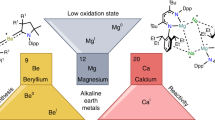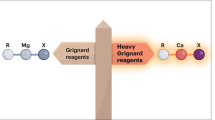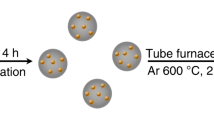Abstract
The last quarter of the twentieth century and the beginning decade of the twenty-first witnessed spectacular discoveries in the chemistry of the heavier main-group elements. The new compounds that were synthesized highlighted the fundamental differences between their electronic properties and those of the lighter elements to a degree that was not previously apparent. This has led to new structural and bonding insights as well as a gradually increasing realization that the chemistry of the heavier main-group elements more resembles that of transition-metal complexes than that of their lighter main-group congeners. The similarity is underlined by recent work, which has shown that many of the new compounds react with small molecules such as H2, NH3, C2H4 or CO under mild conditions and display potential for applications in catalysis.
This is a preview of subscription content, access via your institution
Access options
Subscribe to this journal
Receive 51 print issues and online access
$199.00 per year
only $3.90 per issue
Buy this article
- Purchase on Springer Link
- Instant access to full article PDF
Prices may be subject to local taxes which are calculated during checkout






Similar content being viewed by others
References
Power, P. P. π-bonding and the lone-pair effect in multiple bonds between heavier main group elements. Chem. Rev. 99, 3463–3503 (1999)
Gaspar, P. P. & West, R. Silylene Chemistry of Organic Silicon Compounds 2, Part 3 (eds Rappoport, Z. & Apeloig, Y.) 2463–2568 (Wiley, 1998)
Mizuhata, Y., Sasamori, T. & Tokitoh, N. Stable heavier carbene analogues. Chem. Rev. 109, 3479–3511 (2009)
Linti, G. & Schnöckel, H. Low valent aluminum and gallium compounds, structural variety and coordination modes to transition metal fragments. Coord. Chem. Rev. 206–207, 285–319 (2000)
Stephan, D. W. Frustrated Lewis pairs: a new strategy to small molecule activation and hydrogenation catalysis. Dalton Trans. 3129–3136 (2009)
Power, P. P. Persistent and stable radicals of the heavier group elements and related species. Chem. Rev. 103, 739–809 (2003)
Hicks, R. G. What’s new in stable radical chemistry. Org. Mol. Biochem 5, 1321–1338 (2007)
Lee, V., Ya, Nakamoto, M. & Sekiguchi, A. Making stable radicals of heavy elements of group 14 and 13: the might of silyl substitution. Chem. Lett. 37, 128–133 (2008)
Breher, F. Stretching bonds in main group element compounds — borderlines between biradical and closed shell species. Coord. Chem. Rev. 215, 1007–1043 (2007)
Dasent, W. E. Nonexistent Compounds (Marcel Dekker, 1965)
Taylor, M. J. Metal-to-Metal Bonded States (Academic, 1975)
Pearson, R. G. Electronic spectra and chemical reactivity. J. Am. Chem. Soc. 110, 2092–2097 (1988)
Kutzelnigg, W. Chemical bonding in higher main group elements. Angew. Chem. Int. Edn Engl. 23, 272–295 (1984)
Jacobsen, H. & Ziegler, T. Nonclassical double bonds in ethylene analogues: influence of Pauli repulsion on trans-bending and π-bond strength; a density functional study. J. Am. Chem. Soc. 116, 3667–3679 (1994)
Wells, A. F. Structural Inorganic Chemistry 5th edn 1279 (Clarendon, 1986)
Davidson, P. J. & Lappert, M. F. Stabilization of metals in a low-coordination environment using the bis(trimethylsilyl)methyl ligand: coloured SnII and PbII alkyls M{CH(SiMe3)2}2 . J. Chem. Soc. Chem. Commun. 317 (1973)This paper (and ref. 17) established the existence of heavier main group element analogues of ethylene in the solid state, which displayed large structural differences from their lighter element counterparts.
Goldberg, D. E., Harris, D. H., Lappert, M. F. & Thomas, K. M. A new synthesis of divalent group 4B alkyls M[CH(SiMe3)2]2 (M = Ge or Sn) and the crystal structure of the tin compound. J. Chem. Soc. Chem. Commun. 261–262 (1976)
Goldberg, D. E. et al. Subvalent group 4B alkyls and amides. Part 9 germanium and tin alkene analogues, the dimetallenes M2R4 [M = Ge or Sn; R = CH(SiMe3)2]. X-ray structures, molecular orbital calculations for M2H4 and trends in the series M2R4 1 [M = C, Si, Ge or Sn; R1 = R, Ph, C6H2-Me3-2,4,6 or C6H3Et2-2,6]. J. Chem. Soc. Dalton Trans. 2387–2394 (1986)
Stürmann, M., Weidenbruch, M., Klinkhammer, K. W., Lissner, F. & Marsmann, H. New plumbylenes and a plumbylene dimer with a short lead-lead separation. Organometallics 17, 4425–4428 (1998)
West, R., Fink, M. J. & Michl, J. Tetramesityldisilene, a stable compound with a silicon-silicon double bond. Science 214, 1343–1344 (1981)Described the synthesis and structure of the first stable (that is, non-dissociating) compound with a double bond between two heavier main group elements and (with ref. 35) effectively overthrew the so-called double bond rule, which holds that heavier main group elements do not form stable double bonds (see refs 10 and 13).
Sekiguchi, A., Kingo, R. & Ichinohe, M. A stable compound with a silicon-silicon triple bond. Science 305, 1755–1757 (2004)
Stender, M., Phillips, A. D., Wright, R. J. & Power, P. P. Synthesis and characterization of a digermanium analogue of an alkyne. Angew. Chem. Int. Edn 41, 1785–1787 (2002)
Phillips, A. D., Wright, R. J., Olmstead, M. M. & Power, P. P. Synthesis and characterization of 2,6-Dipp2-H3C6SnSnC6H3-2,6-Dipp2 (Dipp = C6H3-2,6-Pri 2): a tin analogue of an alkyne. J. Am. Chem. Soc. 124, 5930–5931 (2002)
Pu, L., Twamley, B. & Power, P. P. Synthesis and characterization of 2,6-Trip2H3C6PbPbC6H3-2,6-Trip2 (Trip = C6H2-2,4,6-i-Pr3): a stable heavier group 14 element analogue of an alkyne. J. Am. Chem. Soc. 122, 3524–3525 (2000)
Bader, R. F. W. Vibrationally induced perturbations of molecular electron distribution. Can. J. Chem. 40, 1164–1175 (1962)Showed how certain vibrational modes permitted symmetry allowed second order Jahn–Teller mixing, which could lead to large geometrical perturbations.
Pearson, R. G. Symmetry rule for predicting molecular structure. J. Am. Chem. Soc. 91, 4947–4955 (1969)
Pearson, R. G. Concerning Jahn-Teller effects. Proc. Natl Acad. Sci. USA 72, 2104–2106 (1975)
Grev, R. S. Structure and bonding in the parent hydrides and multiple bonded silicon and germanium compounds: from MHn to R2M = M'R2 and RM≡M'R. Adv. Organomet. Chem. 33, 125–170 (1991)
Albright, T. A., Burdett, J. K. & Whangbo, M. H. Orbital Interactions in Chemistry 166–177 (Wiley, 1985)
Carter, E. A. & Goddard, W. A. Relation between the singlet-triplet gaps and bond energies. J. Phys. Chem. 90, 998–1001 (1986)
Trinquier, G. & Malrieu, J.-P. Non-classical distortions at multiple bonds. J. Am. Chem. Soc. 109, 5303–5315 (1987)
Grützmacher, H. & Fässler, T. Topographical analysis of homonuclear multiple bonds between main group elements. Chem. Eur. J. 6, 2317–2325 (2000)
Su, J., Li, X.-W., Crittendon, R. C. & Robinson, G. H. How short is a Ga-Ga triple bond? Synthesis and molecular structure of Na2[Mes*2C6H3GaGaC6H3-Mes*2] (Mes* = 2,4,6-Pri 3C6H3): the first gallyne. J. Am. Chem. Soc. 119, 5471–5472 (1997)Reported the first formal triple bond between two main group metals, but because the multiple bond was bridged by alkali metal ions and its structure was strongly bent, its description as triple-bonded initiated an illuminating debate on multiple bonding between main group elements.
Zhu, Z. et al. Synthesis, characterization and real molecule calculations for neutral organogallium(I) aryl dimers and monomers: weakness of gallium-gallium bonds in digallenes and digallynes. Chem. Eur. J. 15, 5263–5272 (2009)
Yoshifuji, M., Shima, I., Inamoto, N., Hirotsu, K. & Higuchi, T. Synthesis and structure of bis(2,4,6-tri-tert-butylphenyl)diphosphene: isolation of a true phosphabenzene. J. Am. Chem. Soc. 103, 4587–4589 (1981)Along with the disilene in ref. 20, the description of the first stable phosphorus–phosphorus double bond vitiated the double bond rule.
Tokitoh, N., Arai, Y., Okazaki, R. & Nagase, S. Synthesis and characterization of a stable dibismuthene: evidence for a bismuth-bismuth double bond. Science 277, 78–80 (1997)
Kubas, G. J. Metal Dihydrogen and σ-Bond Complexes: Structure, Theory and Reactivity (Kluwer Academic, 2001)
Spikes, G. H., Fettinger, J. C. & Power, P. P. Facile activation of dihydrogen by an unsaturated heavier main group compound. J. Am. Chem. Soc. 127, 12232–12233 (2005)Reported the first uncatalysed reactions of H 2 with a main group molecule under ambient conditions.
Peng, Y. et al. Addition to H2 to distannynes under ambient conditions. Chem. Commun. (Camb.) 6042–6044 (2008)
Zhu, Z. et al. Addition of hydrogen or ammonia to a low valent group 13 metal species at 25°C and 1 atmosphere. Angew. Chem. Int. Edn 48, 2031–2033 (2009)
Frey, G. D., Lavallo, B., Donnadieu, B., Schoeller, W. W. & Bertrand, G. Facile spitting of hydrogen and ammonia by nucleophilic activation at a single carbon center. Science 316, 439–441 (2007)Reported the first reactions of a carbene with H 2 and NH 3 under ambient conditions.
Welch, G. C., San Juan, R. R., Masuda, J. D. & Stephan, D. W. Reversible metal-free hydrogen activation. Science 314, 1124–1128 (2006)Introduced the frustrated Lewis pair concept and showed how a phosphine borane combination could reversibly bind H 2 under near-ambient conditions.
Chase, P. A. & Stephan, D. W. Hydrogen and amine activation by a frustrated Lewis pair of a bulky N-heterocyclic carbene and B(C6F5)3 . Angew. Chem. Int. Edn 47, 7433–7437 (2008)
Holschumacher, D., Bannenberg, T., Hrib, C. G., Jones, P. G. & Tamm, M. Heterolytic dihydrogen activation by frustrated carbene-borane Lewis pair. Angew. Chem. Int. Edn 47, 7428–7432 (2008)
Sumerin, V. et al. Facile heterolytic H2 activation by amines and B(C6F5)3 . Angew. Chem. Int. Edn 47, 6001–6003 (2008)
Sumerin, V. et al. Molecular tweezers for hydrogen: synthesis and characterization and reactivity. J. Am. Chem. Soc. 130, 14117–14118 (2008)
Wang, H., Frölich, R., Kehr, G. & Erker, G. Heterolytic dihydrogen activation with the 1,8-bis(diphenylphosphino) naphthalene/B(C6F5)3 pair and its application for metal free catalytic hydrogenation of silylenol ethers. Chem. Commun. (Camb.) 5966–5968 (2008)
Peng, Y., Ellis, B. D., Wang, X. & Power, P. P. Diarylstannylene activation of hydrogen or ammonia with arene elimination. J. Am. Chem. Soc. 130, 12268–12269 (2008)
Zhao, J., Goldman, A. S. & Hartwig, J. S. Oxidative addition of ammonia to form a stable, monomeric amino hydride complex. Science 307, 1080–1082 (2005)
Power, P. P. The bonding and reactivity of heavier group 14 alkyne analogues. Organometallics 26, 4362–4372 (2007)
Stender, M., Phillips, A. D. & Power, P. P. Formation of [Ar*GE{CH2C(Me)C(Me)CH2}CH2C(Me)=]2 (Ar* = C6H3-2,6-Trip2; Trip = C6H2-2,4,6-i-Pr3) via reaction of Ar*GeGeAr* with 2,3-dimethyl-1,3-butadiene: evidence for the existence of a germanium analogue of an alkyne. Chem. Commun. 1312–1313 (2002)
Kinjo, R. et al. Reactivity of the disilyne RSiSiR (R = SiiPr[CH(SiMe3)2]2) toward π-bonds: stereo specific addition and a new route to an isolable 1,2-disilabenzene. J. Am. Chem. Soc. 129, 7766–7767 (2007)
McCahill, J. S., Welch, G. C. & Stephan, D. W. Reactivity of “frustrated Lewis pairs:” three component reactions of phosphines, a borane and olefin. Angew. Chem. Int. Edn 46, 4968–4971 (2007)
Sita, L. R. & Bickerstaff, R. D. Synthesis and crystal structure of the first stannacyclopropene derivative. J. Am. Chem. Soc. 110, 5208–5209 (1988)
Peng, Y., Ellis, B. D., Wang, X., Fettinger, J. C. & Power, P. P. Reversible reactions of ethylene with distannynes under ambient conditions. Science 325, 1668–1670 (2009)This paper and ref. 58 reported reversible binding of the unsaturated species C 2 H 4 and CO 2 by a main group molecule under ambient conditions.
Seyferth, D. [(C2H4)PtCl3]-, the anion of Zeise’s salt K[C(C2H4)PtCl3]·H2O. Organometallics 20, 2–6 (2001)
Otten, E., Neu, R. C., Erker, G. & Stephan, D. W. Complexation of nitrous oxide by frustrated Lewis pairs. J. Am. Chem. Soc. 131, 9918–9919 (2009)
Mömming, C. M. et al. Reversible metal-free carbon dioxide binding by frustrated Lewis pairs. Angew. Chem. Int. Edn 48, 6643–6646 (2009)
Chase, P. A., Welch, G. C., Junea, T., Erker, G. & Stephan, D. W. Metal-free catalytic hydrogenation. Angew. Chem. Int. Edn 46, 8050–8053 (2007)
Spies, P. et al. Metal free catalytic hydrogenation of enamines, imines and conjugated phosphinalkenylboranes. Angew. Chem. Int. Edn 47, 7543–7546 (2008)
Davidson, P. J., Hudson, A., Lappert, M. F. & Lednor, P. W. Tris[bis(trimethylsilyl)methyl]tin(III), R3Sn·: an unusually stable stannyl radical, from photolysis of R2Sn. J. Chem. Soc. Chem. Commun. 829–830 (1973)
Gynane, M. J. S., Hudson, A., Lappert, M. F., Power, P. P. & Goldwhite H Synthesis and electron spin resonance study of stable dialkyls and diamides of phosphorus and arsenic R2 1M·and (R2 2N)2M·. J. Chem. Soc. Chem. Commun. 623–624 (1976)
Chivers, T. A Guide to Chalcogen-Nitrogen Chemistry (World Scientific, 2005)
Niecke, E., Fuchs, A., Baumeister, F., Nieger, M. & Schoeller, W. W. A. P2C2 four-membered ring with unusual bonding synthesis structure and ring opening of a 1,3-diphosphacyclobutane-2,4-diyl. Angew. Chem. Int. Edn Engl. 34, 555–557 (1995)This paper and ref. 65 were the first reports to recognise the existence of stable singlet diradicaloid species.
Scheschkewitz, D. et al. Singlet diradical from transition states to crystalline compounds. Science 295, 1880–1881 (2002)
Sita, L. R. Structure/property relationships of polystannanes. Adv. Organomet. Chem. 38, 189–243 (1995)
Dai, X., Kapoor, P. & Warren, T. H. [Me2NN]Co(η6-toluene): O = O, N = N and O = N bond cleavage provides β-diketiminato cobalt µ-oxo and imido complexes. J. Am. Chem. Soc. 126, 4798–4799 (2004)
Cui, C., Brynda, M. A., Olmstead, M. M. & Power, P. P. Synthesis and characterization of the non-Kekule singlet diradicaloid Ar′Ge(µ-NSiMe3)2GeAr′ (Ar′ = 2,6-Dipp2C6H3, Dipp = 2,6-PriC6H3). J. Am. Chem. Soc. 126, 6510–6511 (2004)
Wang, X., Peng, Y., Olmstead, M. M., Fettinger, J. C. & Power, P. P. An unsymmetric oxo/imido-bridged germanium-centered singlet diradicaloid. J. Am. Chem. Soc. 131, 14164–14165 (2009)
Schoeller, W. W., Rozhenko, A., Bourissou, D. & Bertrand, G. The electronic structures of 1,3-diboracyclobutane-1,3-diyls and their valence and isomers with a B2E2 skeleton (E = N, P, As). Chem. Eur. J. 9, 3611–3617 (2003)
Jung, Y. & Head-Gordon, M. Controlling the extent of diradical character by utilizing neighboring group interactions. J. Phys. Chem. A 107, 7475–7481 (2003)
Seierstad, M., Kinsinger, C. R. & Cramer, C. J. Design optimization of 1,3-diphospha-2,4-diboretane diradicals. Angew. Chem. Int. Edn 41, 3894–3896 (2002)
Amii, H., Vranicar, H., Gornitzka, H., Bourissou, D. & Bertrand, G. Radical type reactivity of the 1,3-dibora-2,4-diphosphonio cyclo-butane-1,3-diyl. J. Am. Chem. Soc. 126, 1344–1345 (2004)
Jung, Y., Brynda, M., Power, P. P. & Head-Gordon, M. Calculations on the electronic structure of heavier alkyne congeners: diradical character and reactivity. J. Am. Chem. Soc. 128, 7185–7192 (2006)
Lee, S. C. & Holm, R. H. Speculative synthetic chemistry and the nitrogenase problem. Proc. Natl Acad. Sci. USA 100, 3595–3600 (2008)
Resa, I., Carmona, E., Guttierez-Puebla, E. & Monge, A. Decamethyldizincocene a stable compound with a zinc-zinc bond. Science 205, 1136–1138 (2004)
Green, S. P., Jones, C. & Stasch, A. Stable magnesium(1) compounds. Science 318, 1754–1757 (2007)
Wang, Y. et al. A stable silicon(O) compound with an Si-Si double bond. Science 321, 106–107 (2008)
Acknowledgements
I thank the US NSF and the US Department of Energy Office of Basic Energy Sciences for financial support.
Author information
Authors and Affiliations
Corresponding author
Rights and permissions
About this article
Cite this article
Power, P. Main-group elements as transition metals. Nature 463, 171–177 (2010). https://doi.org/10.1038/nature08634
Issue Date:
DOI: https://doi.org/10.1038/nature08634
This article is cited by
-
A crystalline aluminium–carbon-based ambiphile capable of activation and catalytic transfer of ammonia in non-aqueous media
Nature Chemistry (2024)
-
Adsorption profiles of chlorinated industrial gases on metal (Cu, Mn and Ni) doped fullerenes using DFT, QTAIM and NCI analysis
Chemical Papers (2024)
-
A silylene-stabilized ditin(0) complex and its conversion to methylditin cation and distannavinylidene
Nature Communications (2023)
-
Anions featuring an aluminium–silicon core with alumanyl silanide and aluminata-silene characteristics
Nature Chemistry (2023)
-
An isolable germylyne radical with a one-coordinate germanium atom
Nature Chemistry (2023)
Comments
By submitting a comment you agree to abide by our Terms and Community Guidelines. If you find something abusive or that does not comply with our terms or guidelines please flag it as inappropriate.



